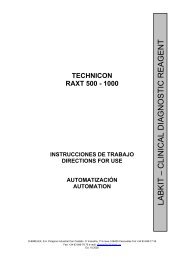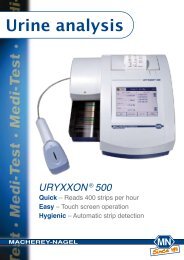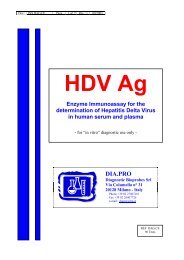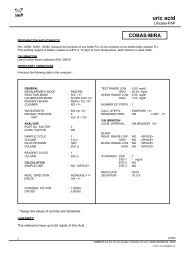[SAS-MX Acid Hb]. - Agentúra Harmony vos
[SAS-MX Acid Hb]. - Agentúra Harmony vos
[SAS-MX Acid Hb]. - Agentúra Harmony vos
- No tags were found...
Create successful ePaper yourself
Turn your PDF publications into a flip-book with our unique Google optimized e-Paper software.
INTERPRETATION OF RESULTSQualitative Evaluation:The possible identity of the haemoglobin types present in the samples can be determined by visualevaluation of the completed gel. The Hemo controls provide a marker for band identification.Figure 1 shows the possible identity of the most commonly encountered haemoglobin types.F AA 2DEGJHO S CMost haemoglobin variants cause no discernible clinical symptoms, so are of interest primarily toresearch scientists. Variants are clinically important when their presence leads to sickling disorders,thalassaemia syndromes, life long cyanosis, haemolytic anaemias or erythrocytosis, or if theheterozygote is of sufficient prevalence to warrant genetic counselling. The combinations of <strong>Hb</strong>S-S,<strong>Hb</strong>S-D-Los Angeles, and <strong>Hb</strong>S-O Arab lead to serious sickling disorders 2 . Several variants including<strong>Hb</strong>H, E-Fort Worth and Lepore cause a thalassaemic blood picture 2 .The two variant hemoglobins of greatest importance in terms of frequency and pathology are <strong>Hb</strong>S and<strong>Hb</strong>C 2 . Sickle cell anaemia (<strong>Hb</strong>SS) is a cruel and lethal disease. It first manifests itself at about 5-6months of age. The clinical course presents agonising episodes of pain and temperature elevations withanaemia, listlessness, lethargy, and infarct in virtually all organs of the body.The individual with homozygous <strong>Hb</strong>CC suffers mild haemolytic anaemia which is attributed to theprecipitation or crystallization of <strong>Hb</strong>C within the erythrocytes. Cases of <strong>Hb</strong>SC disease arecharacterised by haemolytic anaemia that is milder than sickle-cell anaemia.The thalassaemias are a group of haemoglobin disorders characterised by hypochromia andmicrocytosis due to the diminished synthesis of one globin chain (the α or β) while synthesis of theother chain proceeds normally 9,10 . This unbalanced synthesis results in unstable globin chains. Theseprecipitate within the red cell, forming inclusion bodies that shorten the life span of the cell.In α-thalassaemias, the α chains are diminished or absent, and in the β-thalassaemia, the β chains areaffected. Another quantitative disorder of haemoglobin synthesis, hereditary persistent foetalhaemoglobin (HPFH), represents a genetic failure of the mechanisms that turn off gamma chainsynthesis at about four months after birth, which results in a continued high percentage of <strong>Hb</strong>F. It is amore benign condition than the true thalassaemias and persons homozygous for HPFH have normaldevelopment, are asymptomatic and have no anemia 10 .4


![[SAS-MX Acid Hb]. - Agentúra Harmony vos](https://img.yumpu.com/46129828/6/500x640/sas-mx-acid-hb-agentara-harmony-vos.jpg)

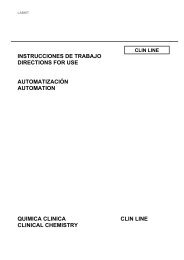
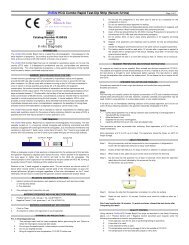
![[APTT-SiL Plus]. - Agentúra Harmony vos](https://img.yumpu.com/50471461/1/184x260/aptt-sil-plus-agentara-harmony-vos.jpg?quality=85)


![[SAS-1 urine analysis]. - Agentúra Harmony vos](https://img.yumpu.com/47529787/1/185x260/sas-1-urine-analysis-agentara-harmony-vos.jpg?quality=85)



